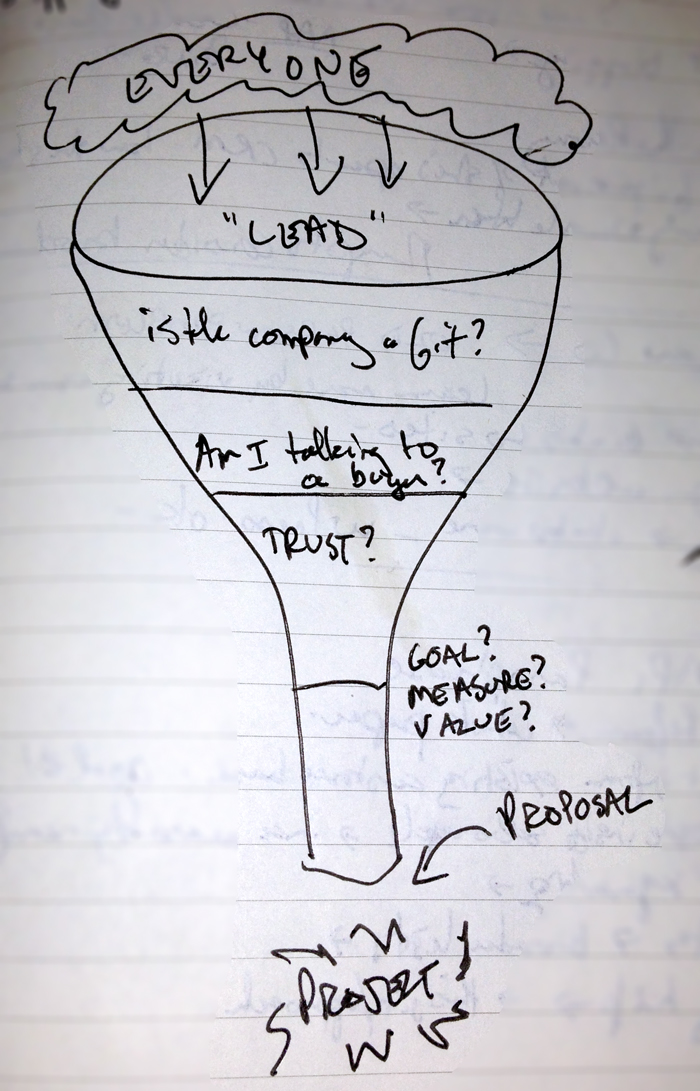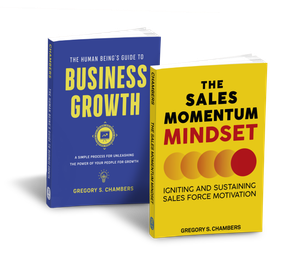A Year Later: My Consulting Sales Process Cheat Sheet
A Year Later: My Consulting Sales Process Cheat Sheet
It's been nearly a year since I hung my shingle out and went looking for clients. I went in with a bunch of assumptions and over the last 10 months have refined a few that I will offer up to those who are interested.
This was prompted by a discussion from a friend, Jill Slupe and her fast growing business Verde-Martin. They do a Sales Audit process that does an excellent job of helping business owners walk through their process in order to get more from it.
That led to a question: Greg, what does your sales process look like?
I started with a sketch that is meant to resemble a funnel.

I won't spend too much time on each step, but in case you can't read my chicken-scratch I will give you a few of the steps.
- Everyone: my funnel starts with everyone I know well, everyone I have met at least once and everyone I share something in common with. It's a big list.
Lead: this happens when I hear of an opportunity. "My company could use more X." is usually how it starts.
Is the Company a Fit? This is a mental exercise that I go through in order to shorten follow up. It starts with "what would I do if I were them" moves into "do they have any money to fix their problems" and ends with "who in the company am I talking to?"
Am I talking to a Buyer? Simply put, can this person prioritize funds or will they have to ask permission to spend?
Trust? This step can take minutes or may take years. Is there any trust between us? Do they believe me and do I believe them? It's pretty easy to get this out by talking about revenue and margins. If I don't get figures, no trust. If the figures don't sound right, I don't trust.
Goal, Measure Value: The GMV. Do we have a goal/target/objective? How will we measure hitting it? What's the value to the company in solving it?
Proposal: This is where I want to live but I've learned to stay away from until I hear the GMV coming out of the client's mouth. At that point I can formulate some ideas and get to solving the problem.
Project: What I get paid to do.
It's pretty simple but the timeframe to work through the process takes time. Here's my cheat sheet in no particular order:
Get to "no" quickly. Maybe is for suckers.
Lots of small "yeses" help move the process along. To get to them, the risk #1 happens faster.
If you see an opportunity, throw it out to a prospect. Most of them say "no" but a few appreciate the effort, it helps build trust and a conversation follows.
Schedule prospecting time. I use 60 minute chunks of time for organizing a list, writing out outlines and making calls. Every day.
Separate contacts into "potential buyers" or "someone who can introduce me to a potential buyer". Not to discriminate, but to know where you are in the funnel.
Things change and new information shows up daily, so keep track of all contacts to see if they are labeled correctly.
Stay generalized in offerings. It's harder, but every time I get pigeon-holed into explaining what I do and how I do it, I say something that drives a "oh, I get it now - I don't need that".
Clients come up with solutions, your job is to get them off the solution and talking about the desired result.
There's always money for your project, but with small companies you're dealing with the owner's income. It's hard to compete with college or a family vacation. Just sayin'.
Results and referrals speed up the trust process. By a factor of 10.
If you say yes to a tough project with a lowered price structure, you'll regret it. Do something of value for them, don't charge for it, and walk away.
Everyone has advice. Listen and smile.
Most consultants I've met are terrible at prospecting. Unless you're selling sales/marketing consulting.
Working alone you can get a lot of work done quickly. Schedule time out of the office at least 2 days a week for human contact.
My ratios of proposal to closed business is 33% at the time of proposal. Another 33% closes within 4 months. 33% disappears and I can't tell you where they go!
Don't hang your shingle out without having 6 months of income in the bank. That can include a first client gig's revenue.
I gained 15 pounds this year. Don't do that. Schedule exercise. My dog even got fat. (fatter)
Being on the payroll for $150K at a bank and bringing $2.5-3MM of value to the marketplace feels very different.
Diversify your revenue stream. Things change.
Some things are timeless, like a sales process. The tools and engagement may change, but the steps involved are the same. Sell your process tied to their expertise.
Be pessimistic. It may all fall apart. Especially in Dec/Jan/Feb.
Be optimistic. It's going to get better. Especially once your pipeline is feeding you referrals.
Find a mentor. One that you're willing to share the details of your business with. A second pair of eyes.
Study selling techniques. It's using language to help people make a Good Decision. Get past thinking something "sounds cheesy" and figure out why it works. Put it in play and get better at getting to "no" or "yes" in a hurry.
Don't worry about what others think. They're fitting you into a box. Build your own.
That's it. 10 months in and the learning curve is still steep. I've experienced both sides of those 25 tips. The Good, the Bad, and the Ugly. Winning and losing. I'm still standing. Pants a little tighter but no worse for the wear.
For 2014 I am going to venture into 2 new product lines. Online Courses and Coaching. I suspect the learning curve in each product will be as steep as this one is, but if done correctly it should help double the value I bring to the market and increase my % of the growth/value.
And in the end, that's what a business development consultant should do, right?
Good stuff.
About the Author: Greg Chambers is Chambers Pivot Industries. Get more business development ideas from Greg on Twitter.





